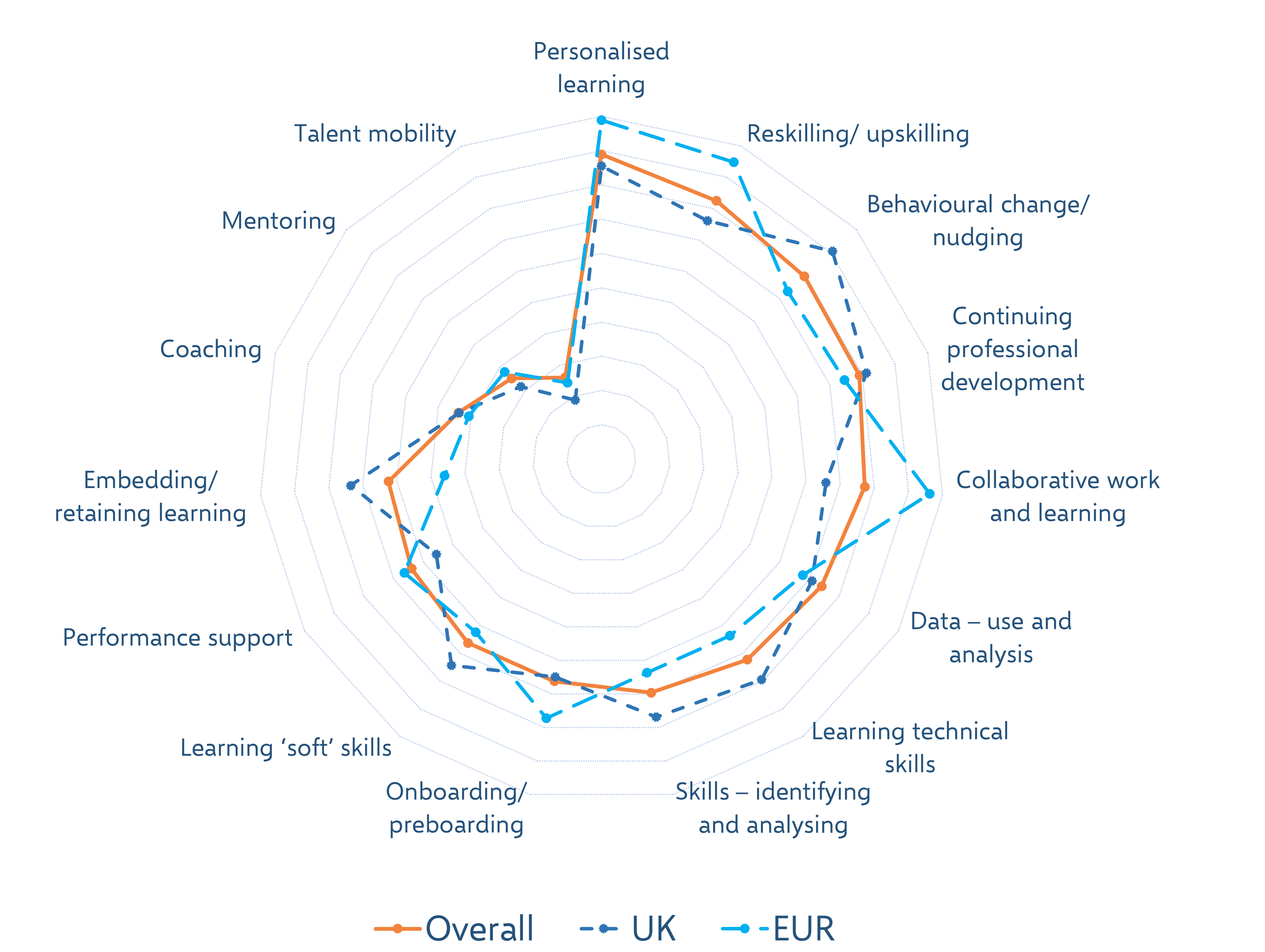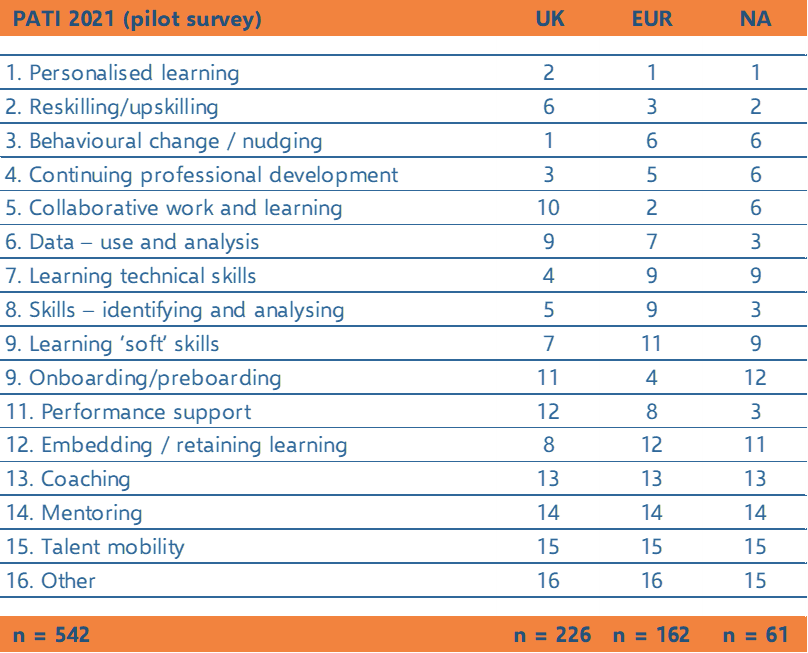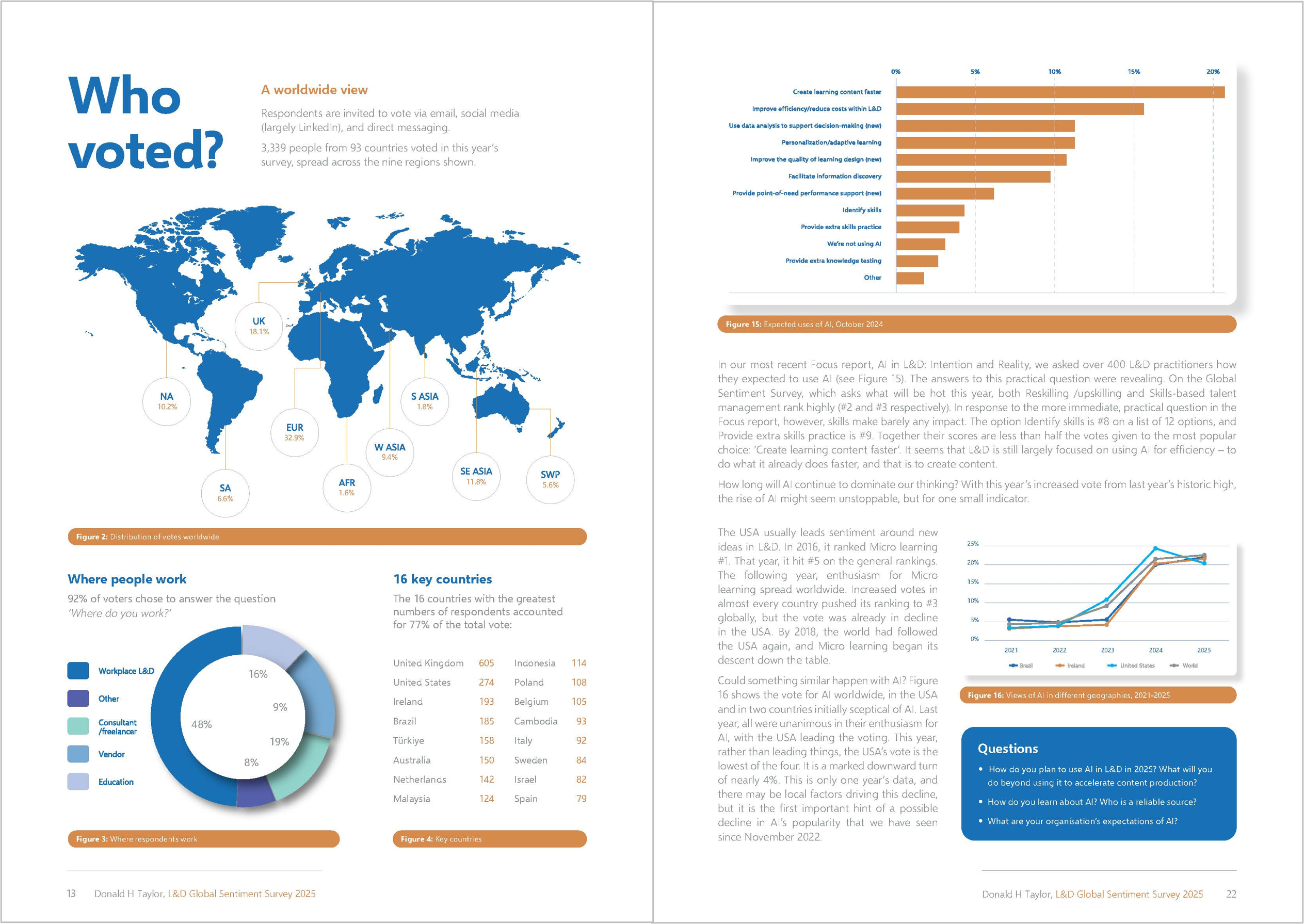Innovation in L&D and HR part 2

In my previous blog, I introduced the People And Technology Innovation survey (PATI), a poll I plan to run annually from summer 2022. It asks one obligatory question: ‘Which HR/L&D issues are you looking to solve with innovative technologies?’
In this blog, I explore how the survey results vary across the UK and continental Europe, with some reference to the North American results. Together, these three geographies account for 83% of the total survey results. (For methodology and caveats, please see the bottom of this blog.)
This year’s poll was a pilot, testing ideas and methodologies, and, inevitably, it lacks the longitudinal data that adds such richness to surveys like the L&D Global Sentiment Survey Part of this blog, then, is my reflections on what we’ll change when running PATI in 2022.
UK and Europe in brief
This radar diagram shows the results overall, and for the UK and Europe as percentage share of the vote for each of the 15 options. The grey lines increase in value from 1% in the centre to 10% at the periphery:

Here, two key areas of difference stand out. On the right of the diagram, European respondents (9.6%) apparently say they are doing more innovative work in collaboration than those in the UK (6.6%). I’m not sure that the message here is that Europe is more innovative around collaboration. For various reasons, the interpretation may be more subtle than that, as I explain towards the bottom of this post.
Opposite, on the left, UK respondents claim to be innovating more in Embedding/retaining learning. This may be a linguistic issue – embedding and retaining may be words in greater use among native than non-native English speakers. However, I’m not sure that explains the difference: the North American vote for this (6.1%) is almost equidistant between the UK’s (7.4%) and Europe’s (4.6%).
So, if it’s not purely a linguistic issue, why is the UK claiming to innovate so much more on Embedding/retaining learning?
Respondents have a chance to provide more information about their innovations beyond just selecting an option from a list. The poll included an optional, free-text question ‘What are you doing that is innovative?’ Looking through entries made by UK respondents who had chosen Embedding/retaining learning, there was little evidence of people innovating to ensure that learning was retained. However, there was plenty of writing around the way learning activities were being made available outside of regular training events. In other words, it may be that UK respondents saw Embedding/retaining learning and latched onto the first word, so that for them it meant something more like ‘Embedding learning in the flow of work’.
The detail of how words can be interpreted is crucial to running a successful survey, and this is one of many points I will be acting on when redesigning the survey for 2022. (Side note: I don’t believe that providing definitions of terms is the answer to this. Most respondents won’t read them, and their presence risks creating a seductive, but false, sense of certainty about the meaning of the results.)
Results ranked: UK, Europe and USA
Another way to explore the international differences is in the table below, showing the rankings for the UK, Europe and North America.

Starting at the bottom of the table, there is striking unanimity in all three geographies about the amount of innovation taking place across Coaching, Mentoring and Talent mobility.
At the top of the table, however, things are different.

All three of these territories are innovating strongly in the field of Personalised learning. However, while Europe and North America claim to be innovating strongly in Reskilling/upskilling, that falls into sixth place on the UK rankings. Given that Reskilling/upskilling dominated the results of the L&D Global Sentiment Survey for 2021 across all regions, including the UK, I cannot explain why it should rank at a comparatively lowly #6, unless there is a linguistic issue here, and people have instead labelled their innovation as Continuing professional development, ranked #3 in the UK but lower for Europe and North America.
Option 5 provides, perhaps, the most striking differences between the three territories. This is the option on the far right of the radar diagram at the top of this blog. Collaborative work and learning ranked #2 in Europe, but #6 in the US and #10 in the UK. In the L&D Global Sentiment Survey for 2021, Collaborative/social learning ranked second across over 3,000 respondents world-wide in reply to the question ‘What will be hot in workplace learning in 2021?’ It was the only option on the survey that increased its share of the vote in comparison with the previous year and one might have expected that popularity to be reflected in workplace innovation.
So why the stark difference between Europe and the UK on the matter of collaboration?
As mentioned above, respondents can provide more information about their innovations beyond selecting an option from a list, using the optional, free-text question ‘What are you doing that is innovative?’ Respondents that selected Collaborative work and learning typically wrote almost nothing about this in their responses, however. Instead, they focused on other innovative activities.
One likely interpretation of this is that collaboration was not key to these respondents’ innovation. They may have added it to their list of innovations almost as an afterthought. (Respondents could select any number of areas of innovation. The average selection was 4.8 of the 15 options.) If this is the case, why did European respondents do this more than those from the UK?
The answer may in part be down to familiarity. The four areas in which Europe clearly outscored the UK are:
Personalised learning
Reskilling/upskilling
Collaborative work and learning
Onboarding/preboarding.
These are all terms which are widely used internationally. The ones where Europe’s vote is furthest behind the UK’s are:
Embedding/retaining learning
Skills – identifying and analysing
Learning technical skills
These are by no means difficult to understand, but they are not phrases which are part of the regular conversation of L&D. Perhaps for non-native English speakers this may be enough to make a slight difference. When we run the survey again in 2022, we will set a maximum of 3 options from the list of 15, which will force respondents to consider their choices more carefully. This may overcome this issue.
Conclusion
Does geography matters in L&D and HR innovation? The answer is clearly yes, but we can’t yet explain why. In running the Global Sentiment Survey I found it took several years before longitudinal trends around geography became clear, and I expect the PATI survey to be the same.
In the next blog: does a respondent’s place of work affect their answers? (Hint: yes, it does.)
Methodology
The 2021 pilot PATI survey ran from 16 August to 3 October 2021, and attracted 542 responses from 50 countries. People were invited to respond via a combination of social media and direct email. Participation was anonymous, with the option to share an email address.
PATI 21 asked one obligatory question: Which HR/L&D issues are you looking to solve with innovative technologies? The aim in asking a single obligatory question is to make it easy to answer the survey, ensuring a large data set to work with. Respondents were given a list of 15 options to choose from, plus a free-text ‘other’ option.
In addition, there were 4 other, optional questions, plus a final option to share an email address if respondents wanted to stay in touch. The optional questions invited respondents to explain where they were innovating, the challenges they faced and the companies they were working with. They were also given 6 choices to describe where they worked.
Caveats
• Respondents are a self-selecting group, so may not represent the overall population of L&D and HR professionals
• ‘Innovation’ is not defined
• Options on the list are not defined, so we cannot guarantee that respondents all understand the options in the same way.
• The survey is only in English, so native and non-native speakers may interpret the meaning of the same option differently
• Respondents are likely to be more tech-savvy than the general L&D/HR population
• Respondents are unqualified


